| Japonica lutea | |
|---|---|
 | |
| Scientific classification | |
| Kingdom: | |
| Phylum: | |
| Class: | |
| Order: | |
| Family: | |
| Genus: | |
| Species: | J. lutea |
| Binomial name | |
| Japonica lutea | |
Japonica lutea is a small butterfly found in the East Palearctic that belongs to the lycaenids or blues family.
| Japonica lutea | |
|---|---|
 | |
| Scientific classification | |
| Kingdom: | |
| Phylum: | |
| Class: | |
| Order: | |
| Family: | |
| Genus: | |
| Species: | J. lutea |
| Binomial name | |
| Japonica lutea | |
Japonica lutea is a small butterfly found in the East Palearctic that belongs to the lycaenids or blues family.
Z. lutea Hew. (74 f). The outer margin of the wings strongly rounded. particularly in the female; hind wing with a long tail. Honey-yellow, the forewing with a broad black distal border. Underside with a white submarginal line, which separates the disc from the orange-red distal margin; on the disc white- edged bands, a short similar hand on the cross-veins of the forewing. In Amurland and Japan. — Larva on Quercus mongolica , very frequently infested with the larvae of Diptera. The butterflies occur in August on wide roads in forests of high trees and also in bush-woods; they are rather plentiful in many places. The Continental specimens do not differ from Japanese ones; the black border of the forewing varies rather strongly in width among the individuals from the same locality. [2]
The larva on feeds on Quercus mongolica , other Quercus and Cyclobalanopsis glauca .

The brown hairstreak is a butterfly in the family Lycaenidae. The range includes most of the Palaearctic.

The purple hairstreak is a butterfly in the family Lycaenidae distributed throughout much of Europe, North Africa, Anatolia, Caucasia, and Transcaucasia. The larva feeds on Quercus robur, Quercus petraea, Quercus cerris and Quercus ilex.

The black hairstreak is a butterfly in the family Lycaenidae.
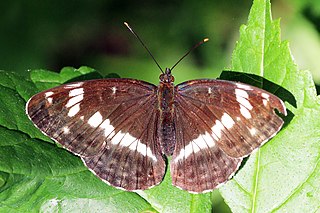
Limenitis camilla, the (Eurasian) white admiral, is a butterfly of the family Nymphalidae. It is found in woodland throughout southern Britain and much of Europe and the Palearctic, extending as far east as Japan.

Lasiommata megera, the wall or wall brown, is a butterfly in the family Nymphalidae. It is widespread in the Palearctic realm with a large variety of habitats and number of generations a year.

Polyommatus eros, the Eros blue or common meadow blue, is a species of blue butterfly found in the Palearctic.

The scarce large blue is a species of butterfly in the family Lycaenidae. It is found in Austria, Slovenia, Croatia, the Czech Republic, France, Georgia, Germany, Hungary, Italy, Japan, Kazakhstan, Mongolia, the Netherlands, Poland, Romania, Russia, northern Serbia, Spain, Switzerland, and Ukraine and East across the Palearctic to Japan. The species was first described by Johann Andreas Benignus Bergsträsser in 1779.

Coenonympha oedippus, the false ringlet, is a species of butterfly in the subfamily Satyridae. It is found in Austria, Belgium, the Netherlands, France, Hungary, Italy, Japan, Kazakhstan, Liechtenstein, Mongolia, Poland, Russia, Slovakia, Slovenia, Spain, Switzerland, and Ukraine. It is extirpated from Bulgaria, Germany, and Slovakia.

Coenonympha arcania, the pearly heath, is a butterfly species belonging to the family Nymphalidae. It can be found in Central Europe. It resembles Coenonympha hero. Seitz describes it thus C. arcania L.. Forewing fiery reddish yellow with black distal margin, hindwing dark brown. Easily recognised by the underside of the hindwing, whose marginal portion is occupied by a broad white band, which in the nymotypical form interrupts the row of ocelli below the apical eye, the latter therefore appearing to be placed on the inside of the white band. All Europe except great Britain, from Scandinavia to the Mediterranean sea and from Spain and France to the Black sea and Armenia. — Specimens with a very broadly black margin to the forewing and a narrowed and slightly dentate band on the underside of the hindwing, which probably occur among nymotypical specimens everywhere, but especially in the South, are considered as ab. insubrica Frey. — Larva green with dark dorsal stripe bordered with a yellowish tint, light subdorsal stripe and pale yellow lateral stripe; head blue-green, mouth and anal fork red. Until May on grasses. Pupa brown, with whitish wing-cases edged with red. Butterflies very common in June and July and often flying together in large numbers. At the edge of woods full of undergrowth, but also in the open country and on hills. They affect flying round bushes and settle on the tip of low twigs, but sometimes also fly up into the higher branches of trees. The females are much less numerous than the males and appear later.

Tomares ballus, the Provence hairstreak or cardenillo, is a butterfly of the family Lycaenidae. It is found on the Iberian Peninsula, northern Africa and along the Mediterranean coast of France.

Polyommatus escheri, Escher's blue, is a butterfly of the family Lycaenidae. It is found in Southern Europe and Morocco.
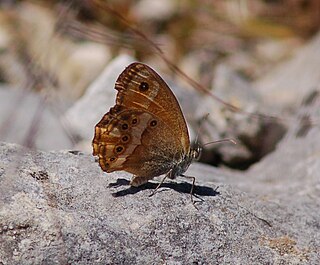
Coenonympha dorus, the dusky heath, is a butterfly of the family Nymphalidae. It is found in south-western Europe and North Africa.

Iolana iolas, the iolas blue, is a butterfly of the family Lycaenidae. It is found in northern Africa, southern Spain, southern France, southern Europe, Asia Minor and Iran. The wingspan of the male is 18–21 mm. The flight period is May to June in rocky places at around 2,000 m. The larva feeds on Colutea arborescens.

Mimoides lysithous is a species of butterfly in the family Papilionidae. It is found in the Neotropical realm.
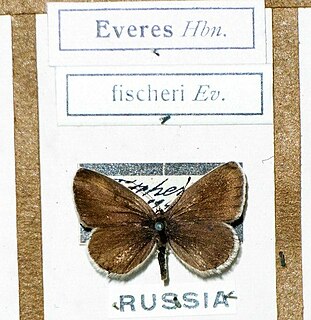
Tongeia fischeri, or Fischer's blue, is a butterfly of the family Lycaenidae. It was described by Eduard Friedrich Eversmann in 1843. It is found in south-eastern Europe, the southern Ural, northern and eastern Kazakhstan, south-western and southern Siberia, the Russian Far East, Mongolia, China, Korea and Japan.
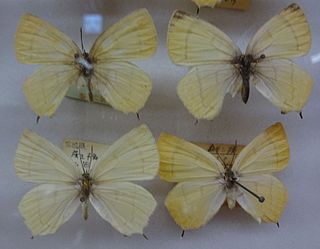
Shirozua jonasi, the orange hairstreak, is a butterfly of the subfamily Lycaeninae. It was described by Edward Wesley Janson in 1877. It is found in the Russian Far East, north-eastern China, Korea and Japan. It is widely distributed in the forest belt.
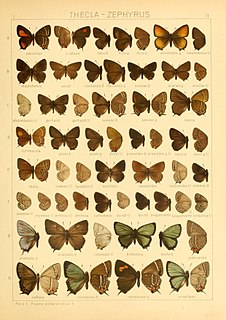
Chrysozephyrus brillantinus is a small butterfly found in the East Palearctic that belongs to the lycaenids or blues family.

Chrysozephyrus smaragdinus is a small butterfly found in the East Palearctic that belongs to the lycaenids or blues family.
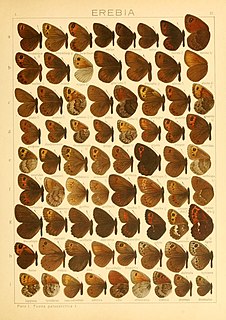
Erebia dabanensis is a small butterfly found in the East Palearctic that belongs to the browns family.

Mimathyma schrenckii is a butterfly found in the East Palearctic that belongs to the Nymphalidae family.
| | This Theclinae-related article is a stub. You can help Wikipedia by expanding it. |